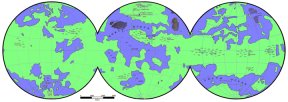
 |
Venus |
 |
Venus is a hothouse world of shallow oceans, steaming tropical jungles, bogs, swamps, marshes, perpetual overcast, and heavy rainfall. The dense jungles of the Venusian lowlands produce numerous plants for which there is a great demand on Earth by chemists, dyemakers, pharmaceutical companies, and florists (the Cytherian Orchid is especially valued for its beauty and its hauntingly subtle fragrance). The lowlands are also home to hundreds of varieties of giant reptilian creatures, called dinosaurs, and to the savage Lizardmen. Humans find the lowlands almost unbearable and tend to stick to the the few highland plateaus, where life is more tolerable and the sun can occasionally be glimpsed through the overcast.
![]() Back to the Space: 1889 homepage.
Back to the Space: 1889 homepage.
![]()
Space:1889 is Frank Chadwick's registered trademark for his game of Victorian Era space-faring. He has granted permission for the use of the background of Space:1889 for the stories presented here. All text, illustrations, photographs and design are © 2000-2007 Dan Thompson, except where otherwise noted.